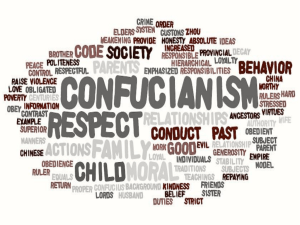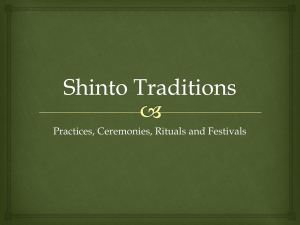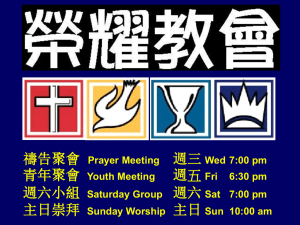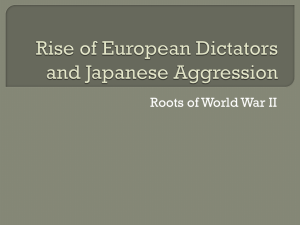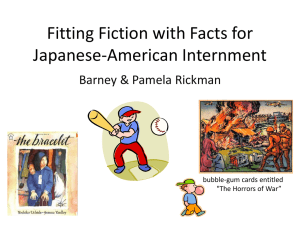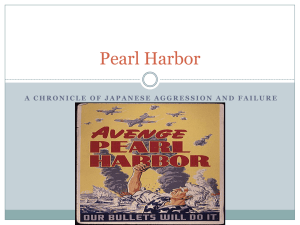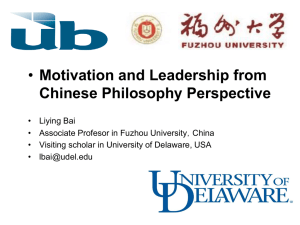Shinto
advertisement
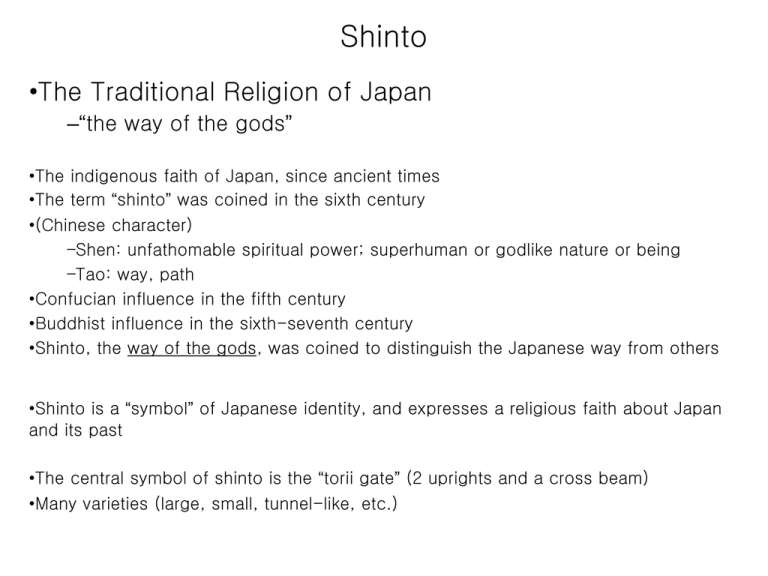
Shinto •The Traditional Religion of Japan –“the way of the gods” •The indigenous faith of Japan, since ancient times •The term “shinto” was coined in the sixth century •(Chinese character) –Shen: unfathomable spiritual power; superhuman or godlike nature or being –Tao: way, path •Confucian influence in the fifth century •Buddhist influence in the sixth-seventh century •Shinto, the way of the gods, was coined to distinguish the Japanese way from others •Shinto is a “symbol” of Japanese identity, and expresses a religious faith about Japan and its past •The central symbol of shinto is the “torii gate” (2 uprights and a cross beam) •Many varieties (large, small, tunnel-like, etc.) • • • • • • • A very loosely-organized religion – No founder – No official sacred scripture – No fixed system of ethics or doctrines – No belief in original sin or original ignorance – No savior – No eschatology – No real sense of history Shinto is shrine-centered and ritual-centered; not book-centered Shinto may be regarded as an ensemble of peculiarly Japanese types of religious beliefs, sentiments, and approaches, which have been shaped and conditioned by the historical experience of the Japanese people from the prehistoric period to the present Shinto is “caught, not taught” (transmitted from heart to heart through daily life) Ono, pp. ix, x, xi, An amalgam of attitudes, ideas, and ways of doing things that, over time, have become an integral part of the way of the Japanese people A religion of joy, beauty of nature, wonder of life, peace and harmony with nature, and among people • The oral myths and traditions of Shinto were preserved in primary documents – – • Kojiki (includes the shinto creation myth) Nihon Shoki The Shinto creation myth (from the Kojiki) – – – – – – – – – – – – – – – – – – A cosmic egg gave rise to heaven and earth There were 3 self-created deities Then there were 7 generations of deities Seventh generation included Izanagi (male who invites) & Izanami (female who invites) Like Adam and Eve, or brother and sister* Heavenly floating bridge and a jeweled spear The silt which dripped down became the Japanese islands They descended from the High Plane of Heaven to the island Onogoro) WS 118 They married and gave birth to many deities Izanami died, burned to death by the kami of fire Izanagi was unclean and washed himself (WS 520-21) Mouth=; ear=; eye=Amaterasu (ancestor of emperor) Amaterasu’s divine grandson = Ninigi 3 gifts: a mirror, a sword, and a string of jewels Ninigi’s grandson--- Jimmu Tenno (660 BC) – the first human emperor of Japan An unbroken line of descent from 660 BC until today (emperor worship) WS 259 Hirohito disavowed Japan is the center of the world, and is of divine origin (WS195) • • This creation myth simply mentions the process of creation of the world (Japan) There is no notion of good or evil in this myth • • The Japanese love Japan and find it hard to conceive of anything else Shinto emphasizes a worshipful attitude toward nature, and toward the beauty of nature The natural beauty of Japan is miniaturized and brought down to human scale in the formal garden (Japanese garden) • • The Shinto View of God Polytheism/animism Japanese myths mention the existence of “eight hundred myriads of kami beings” This is a metaphor to express belief in the sacredness of the entire universe • Basic concept is that of the “kami” – Not really a “god” in the Western, Christian sense – Fundamentally, an honorific for noble, sacred spirits – “Above, superior, numinous or sacred nature” – More broadly, the sacred quality of human existence and the universe – There is a “kami power” which is a-moral – Dangerous, rather than malicious – Associated with practically everything (WS 204) – Mt. Fuji is a sacred mountain; home of a goddess; has kami power – Important deities: Amaterasu-o-mi-kami (sun goddess) and Susa-no-wo – There are also natural deities, anthropomorphic deities, conceptual deities, etc. • View of Reality/Cosmos – In ancient shinto mythology there is a 3-tiered (layered) universe – Plane of the high heaven (world of the gods) – The middle land (the manifested world where men and animals live) – The underworld (the land of the dead; unclean and evil spirits reside here) • • • Modern shrine shinto does not present such traditional explanations WS 146 To look upon the spirits of the other world is like a taboo Instead of developing theoretical explanations of the invisible world, shrines were established as sacred places to which the kami could be invited, and where human beings could experience their presence • The kami are invited to come down to our plane, to share in our life here and now The world we live in is progressing from chaos to order, from the confusion of contradictions to a state of harmony and unity. The world gives promise of an unlimited development of life-power • • • • • • The world of shinto is not an isolated, but an all-inclusive world, including all things organic and inorganic. All things come into existence by virtue of the kami The world is not against people The world is filled with the blessings of the kami and is developing through the power of harmony and cooperation • • Shinto is not pessimistic, but optimistic The world is inherently good • That which interferes with human happiness should be expelled. It belongs to another world View of the Human Being • Body & “kami nature” • We should nourish and keep our kami nature pure (WS 139) • Kami nature includes: – Personality – Family tradition – Contributions from others • • • • • • • • • • All living beings are possessed of kami nature No clear line of distinction between a human being and kami (WS 142) Man is conceived of as divine or spirit possessed (man more than woman) Man is of a higher level than animals because of greater kami force There are different degrees of “kami possession” Human beings are the children of kami and ancestors; we are inherently good We have received our life from kami and ancestors We are loved and protected by them Our daily life work is made possible through the blessings of kami & ancestors We are social beings; there is no place for egotism • We are born with a purpose in life • hopes love Ancestors ------ Myself --------------- Descendants ideals care • • We are lineally one Reverence for ancestors is important • Man owes gratitude to the kami and his ancestors for his life, and for their allencompassing love. He also owes much to his present family, his community, and the nation. His life is full of blessings and so he must accept his obligations to society and contribute to the development of all things entrusted to him Rites of passage: – one month after birth, the child is presented to the kami – Weddings; funerals • The human problem • There is no sense of original sin in shinto (as something inherited) • There is a sense of moral evil (as opposed to natural evil) • Evil is an intruder from outside; it does not belong here • • • • The human problem is defilement or “pollution” (impurities) – The sacredness which we have received from the kami has become clouded over Some causes of trouble: – Thoughts/motivations/actions which may release dangerous kami potency – Pride (WS 291a) – Careless speech (WS 353a) – The displeasure of the gods/ancestors/kami (don’t neglect, be loyal, keep them informed and make offerings) (WS 550a) – A failure to measure up to our greatest capacity in relation to our ancestors, family, nation, and descendants (Confucian filial piety) (WS 504b) Defilement or pollution calls for ritual purification (based on the creation myth) Ceremonial purification is of utmost importance – Water, sacred sakaki tree, haraigushi (wooden pole with strips of white paper) • Purification is for the purpose of removing all pollution, unrighteousness, and evil which may hinder life according to the kami way and the efficacy of worship • Ordinarily purification is accomplished by the individual worshipper, layman, or priest, symbolically rinsing the mouth and pouring clear water over the finger tips Salvation or liberation in Shinto • Observe all taboos and avoid pollution • The most important law of salvation calls for obedience to the emperor as a kami being • The world of kami does not transcend the world of human beings WS 682 • We do not need to seek to enter a divine, transcendental world to attain salvation • We bring kami into this world, into the daily life of home, society, and cooperation of people • We experience kami here and now, and salvation is attained in the harmonious and progressive development of this world • In worship, the spirits and kami are invited to the shrine and evil spirits are expelled • Purification before worship is important • Salvation is a worldly salvation • • • In Shinto life is good and death is evil Shinto regards death as evil or a curse Death is not pollution, but it is an abnormality or misfortune Conduct in shinto • All of life is lived in communion and in accord with the mind of the kami, which affords the devout believer constant protection. • Daily life is regarded as “service to the kami” • • • • Conduct is extremely important Right conduct has three motives: – Prudence (self) – Altruism (others) – Love of God (kami) Shinto is opposed to excesses in food or drink, theft, murder, adultery, blasphemy, lying, disrespect to parents, etc. Good conduct involves: – Proper worship – Moral and ethical conduct in society – Maintenance of ceremonial purity • For – – – – – – – – – – • • • • proper worship, it is assumed: Profession of faith in the kami Offerings good and beautiful have been presented Mind and body have been purified Sincerity has been fulfilled Conduct has been courteous and proper The evil heart, selfish desire, strife, dispute, hatred, etc. have been dissolved Conciliation has been practiced A feeling of good will, cooperation, and affection has been realized among the people It is a distinctive feature of Shinto that kami worship is expressed not only from the depth of one’s heart, but in a concrete act of religious worship Good conduct in Shinto requires one to fit into the group pattern and to express one’s kami nature Key virtues in Shinto are: Makoto and Magokoro – WS 514, 515, 516 – Sincerity, faithfulness, a true heart; a pure and sincere heart and mind WS 514a, 515a, 516a, 519b, 520a, 614a • • The Confucian ethic of the 5 great relationships was adapted into Shinto Relationship are very carefully regulated • • • • Mercy WS 684a Honesty WS 718b Learning WS 571a/b Compassion WS 685a/b • • The function of reverence is to honor the Deity in all things; The function of purity is to sustain the manifestation of Deity in oneself Destiny of the human being • One’s kami nature will survive death • A man wants to be worthy of being remembered by his descendants Shrines and the Priesthood • • • • Shrines are served by priests, who are primarily ritualists Being primarily a ritualist, a priest must know how to conduct the rites, ceremonies, and festivals, including the preparation and intoning of the appropriate liturgy • The priest’s ceremonial dress is modeled after the costume of court officials of the Heian period It apparently has no significant symbolic meaning • The Importance of the Shrine and Priesthood • • • • The primary purpose of a shrine is to provide a dwelling place for one or more kami and a place where the kami can be served (worshipped in accordance with shinto beliefs and practices) WS 592 The shintai or “god-body” is contained within the innermost chamber of the shrine sanctuary The presence of this shintai is what makes a building a sanctuary 3 main buildings: – Chief sanctuary (honden: holds the “god-body”) – Hall of offerings (heiden) – clergy officiate here – Hall of worship (haiden) – open to the public for alms giving • Primary shrine in Japan is the Shrine of Ise – Dedicated to Amaterasu (highest deity in shinto pantheon) – Her shintai are a mirror, sword, and jeweled necklace • Pass through the torii gate (winding road; one never approaches the shrine directly) Stop for purification by rinsing with water After alerting the god (kami), usually by clapping, one makes an offering The minimum ritual requirement for the kami is a periodic presentation of offerings • • • • • • Festivals – Very festive occasions – Gion festival (Kyoto) – Aoi festival (Kyoto) – Kamigano Horse Race – Inari rice-planting festival – Festival for boys – Children’s Day Colorful, exciting, dynamic Often the shintai will be removed from its abode in the shrine and carried around the neighborhood, conveying blessings and receiving donations • Varieties of Shinto • Originally there was no shrine – Rites and rituals were conducted at sacred places (foot of a beautiful mountain, next to a waterfall, etc.) – There were at one time nearly 200,000 shrines • • There was also state Shinto, prior to its termination Today, shrine Shinto is the dominant mode • Ryobu Shinto – Shinto and Buddhist combination Suiga Shinto – Shinto and Confucianist combination Yuiitsu Shinto – Shinto apologetics based on the principle of unity • •
